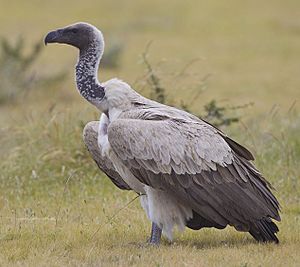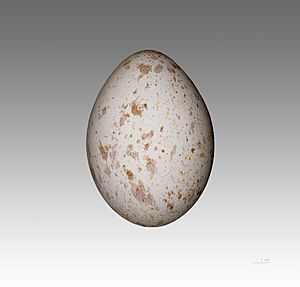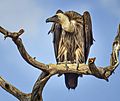White-backed vulture facts for kids
Quick facts for kids White-backed Vulture |
|
|---|---|
 |
|
| Adult in Etosha National Park, Namibia | |
| Conservation status | |
| Scientific classification | |
| Kingdom: | |
| Phylum: | |
| Class: | |
| Order: |
Accipitriformes
|
| Family: |
Accipitridae
|
| Genus: |
Gyps
|
| Species: |
G. africanus
|
| Binomial name | |
| Gyps africanus (Salvadori, 1865)
|
|
The White-backed Vulture is a large bird that lives in Africa. It belongs to a group of birds called Accipitridae, which also includes powerful eagles and fast hawks. These vultures are known for their white backs, which gives them their name! They are very important "clean-up crew" members in their homes, the African grasslands. They help keep the environment tidy by eating what other animals leave behind.
Contents
Where White-backed Vultures Live
White-backed Vultures live in many parts of Africa. You can find them in the wide-open grasslands and savannas. These areas have scattered trees where the vultures can build their nests. They need large, open spaces to find food and fly easily.
What White-backed Vultures Eat
White-backed Vultures are scavengers. This means they mostly eat the remains of dead animals, often called 'carcasses'. They are like nature's clean-up crew! They help get rid of dead animals, which stops diseases from spreading. They often eat what big hunters like lions or hyenas leave behind.
These vultures have very strong stomachs. They can digest meat that might make other animals sick. After a big meal, they spend time cleaning their feathers. This keeps their feathers in good shape for flying.
How They Look and Fly
White-backed Vultures are medium-sized vultures. They have a pale, fluffy neck and a dark body. Their most famous feature is the white patch on their lower back. This patch is easy to see when they are flying.
They are excellent flyers. They use warm air currents, called thermals, to soar high in the sky. They can glide for hours without flapping their wings much. This helps them save energy while searching for food from above. Their sharp eyesight helps them spot carcasses from very far away.
Life Cycle and Reproduction
White-backed Vultures usually build their nests in tall trees. Both parents help build the nest and take care of the young. The female vulture typically lays one egg. The parents take turns sitting on the egg to keep it warm until it hatches.
Once the chick hatches, both parents feed it. They bring back food from their scavenging trips. The young vulture stays in the nest for several months. During this time, it grows its feathers and learns to fly. When it is old enough, it leaves the nest and starts to find its own food.
Why They Are Important
White-backed Vultures play a vital role in their ecosystem. By eating dead animals, they help prevent the spread of diseases. They also help recycle nutrients back into the environment. Without vultures, carcasses would pile up, which could cause health problems for other animals and even humans.
Images for kids
-
feeding on elephant leg, Matetsi Safari Area, Zimbabwe
-
feeding on zebra carcass, Etosha National Park, Namibia
-
Cuando River, Chobe National Park, Botswana
-
Chobe river, Botswana
See also
 In Spanish: Buitre dorsiblanco africano para niños
In Spanish: Buitre dorsiblanco africano para niños













